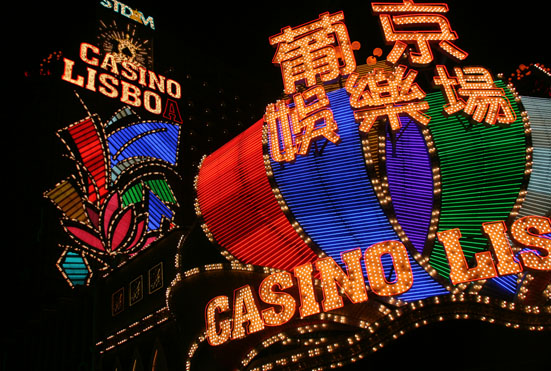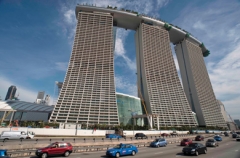 At some point, Peking may decide that Macao is overheated but for the moment it’s simply red-hot. Revenues vaulted 70% last month, to the tune of $2 billion U.S. dollars (or $25,435,856,924 Zimbabwean), the second-best number in Macanese history. Wynn Resorts continues to outperform the competition with its 15% market share. Stanley Ho‘s archipelago of aging casinos still holds fully a third of the market, with Sands China a distant second at 18.5%. Melco Crown International (15%) and Galaxy Entertainment (13%) nip at Wynn’s heels, while MGM Grand Paradise brings up the rear with 7% of market share. (Goldman Sachs puts Sheldon Adelson‘s market share at 20%, shaving a point off both Sociedade de Jogos de Macau and Galaxy.)
At some point, Peking may decide that Macao is overheated but for the moment it’s simply red-hot. Revenues vaulted 70% last month, to the tune of $2 billion U.S. dollars (or $25,435,856,924 Zimbabwean), the second-best number in Macanese history. Wynn Resorts continues to outperform the competition with its 15% market share. Stanley Ho‘s archipelago of aging casinos still holds fully a third of the market, with Sands China a distant second at 18.5%. Melco Crown International (15%) and Galaxy Entertainment (13%) nip at Wynn’s heels, while MGM Grand Paradise brings up the rear with 7% of market share. (Goldman Sachs puts Sheldon Adelson‘s market share at 20%, shaving a point off both Sociedade de Jogos de Macau and Galaxy.)
In terms of cash flow (once Pansy Ho’s take is sifted out), Macao actually represents a less remunerative market for MGM Resorts International than — believe it or not — Detroit. Given that Macao’s casino rebound began a year ago, future gains in revenue are going to become progressively less spectacular as the year plays out. The promised IPO is progressing at a stately pace, meantimes. Junket VIP relationships remain “a new and very important effort.” It should have been very important several years ago — a miscalculation that relegated MGM to perennial last place — but give CEO Jim Murren credit for rethinking a poorly set course. (Predecessor J. Terrence Lanni‘s tenure looks worse and worse in retrospect.) Slot inventory has been upped 20%, with another 15% increase to come, for a total of 1,200 one-armed bandits. Cash flow isn’t thrilling (less than a third of Wynncore Macau‘s) but MGM & Co. are sufficiently bullish to seek a Cotai Strip™ foothold by early 2015 at the latest.
“Venetian Oriental” is the catch-all term for the Traders/Shangri-La/Sheraton agglomeration of hotel towers (4K rooms) that Adelson is striving to complete on the Cotai Strip™. Sands claimed it had 500 workers — far short of what it needs — on site but stock analyst Joseph Greff is skeptical. Since half of the workforce must be Macanese (not the easiest quota to fill), this may account for the discrepancy: Adelson’s lieutenants simply may not have rounded up the necessary 250 resident construction workers.
Macao’s got nothing on its powerful rival to the south, Singapore. Second-quarter cash flow at Marina Bay Sands was $95 million ($1.5 million/day), despite low table hold. This exceeds J.P. Morgan‘s already-optimistic projections by 21%. The firm is accordingly upping its estimates for future quarters. Incidentally, one can’t make apples-to-apples comparisons of Las Vegas Sands to other casino companies because the former doesn’t back rents out of its cash-flow numbers, which tends to make them look better than the competition’s.
Long-term, Morgan now estimates Sands Marina to churn out $964 million in cash flow next year and $1.1 billion the year after that (giving Adelson ROI of 17% and 19%, respectively; close enough to his promised — if once seemingly impossible — 20%). Morgan analysts allow that they “are not jazzed to see a capable manager like [fired CEO] Steve Jacobs leave” Sands China but note that “there seems to have been a revolving door of sorts within the senior management ranks there for some time.”
 Led by Greff, Morgan analysands showed the flag around the Pacific Rim last June. They came away sanguine about Macao and very impressed by Singapore, “which appears to be deep and extremely well-positioned within a financial center in Asia that has limited gaming capacity.” Although nearly all (96%) of the Marina Bay (left) retail space has been leased, only 25% of the shops are presently open. SkyPark is a big hit with tourists and locals, generating long lines, and Greff speculates that the critical mass of hotel rooms (a quarter of which are comped) added by MBS is actually driving up occupancy at nearby competitors, too. Being 15 minutes from the airport doesn’t hurt, either. Neither does the $70/day admission fee for Singaporeans, apparently, although they make up only 1/3 of the customer base — pretty much as the government intended.
Led by Greff, Morgan analysands showed the flag around the Pacific Rim last June. They came away sanguine about Macao and very impressed by Singapore, “which appears to be deep and extremely well-positioned within a financial center in Asia that has limited gaming capacity.” Although nearly all (96%) of the Marina Bay (left) retail space has been leased, only 25% of the shops are presently open. SkyPark is a big hit with tourists and locals, generating long lines, and Greff speculates that the critical mass of hotel rooms (a quarter of which are comped) added by MBS is actually driving up occupancy at nearby competitors, too. Being 15 minutes from the airport doesn’t hurt, either. Neither does the $70/day admission fee for Singaporeans, apparently, although they make up only 1/3 of the customer base — pretty much as the government intended.
Given that VIP junketeers have to pass through the eye of a needle to be approved in Singapore, Sands is pursuing high rollers directly. Even though this requires extending credit, Greff writes that “there is a large margin for error, given the assert [sic] quality and the fact that Singapore is a duopoly.”
But if MBS is looking like the “grand slam home run” about which Adelson is continually crowing — not without justification — Resorts World Sentosa already is one, “targeting the blue collar local Asian market. For our tour last week, [Genting managers] had to struggle to find empty hotel rooms to view.” In its room inventory, Resorts World has lower exposure (1,300 to 2,500) and aims each of its four hotels at a different market segment. Re: pricing and marketing position, MBS is comparatively monolithic. Genting can also bus in 5,400 customers per day vs. MBS’ 600.
Most impressive stat: “The average customer length stay is approximately 3 days.” In other words, Singapore’s casino resorts are already the vacation destination that Macao’s have not managed to become and — dare I say it? — probably never will. Rapid Roulette is a big hit at Resorts World but Rapid Baccarat a flop. Perhaps the real game simply moves fast enough already … or players with bank rolls rich enough to risk baccarat spurn this robotic iteration of James Bond‘s second-favorite form of recreation.

[…] series of rapid games that probably won’t catch on we have Rapid Baccarat! Rapid Baccarat is not off to a good start in Singapore. Rapid Roulette is a big hit at Resorts World but Rapid Baccarat a […]